Hyundai develops world first active shift control tech for hybrids
Active Shift Control transmission technology improves gear-shift efficiency for hybrid vehicles and is now set for mass production; reduces gearshift times by 30%, adds to driving fun, and improves fuel economy.
Hyundai Motor Group has developed the world’s first Active Shift Control (ASC) transmission technology. The innovation optimises transmission efficiency by monitoring gearshifts 500 times per second, precisely adjusting the transmission rotation speed to for faster shift times.
The new technology will premiere in the upcoming Hyundai Sonata Hybrid and eventually benefit other upcoming Hyundai and Kia hybrids.

ASC applies new control logic software to the Hybrid Control Unit (HCU), which then controls the electric motor to align the rotational speeds of the engine and transmission to reduce gear shift time by 30 percent. The technology also delivers smoother gear changes despite quicker shift times.
“The development of world’s first ASC technology is a remarkable innovation which incorporates precise motor control to automatic transmission,” said KyoungJoon Chang, Vice President and Head of Powertrain Control System Group of Hyundai Motor Group, “It will not only save fuel but also provide a more fun driving experience for our customers.”
Reducing gear shift time by 30 percent
Conventional hybrid vehicles do not have torque converters in order to further improve fuel economy as torque converters lose energy during the process of transmission. Although fuel efficient, such a system also requires longer shift times to ensure smoother gear changes.
ASC technology allows the hybrid’s electric motor to also take control of gear shifts by applying new software logic to the Hybrid Control Unit (HCU) to mitigate issues with slower shift time. The HCU monitors the rotational speed of transmission with a sensor installed inside the electric motor at 500 times per second to quickly synchronise the rotational speed with that of engine.
With the synchronisation, shift time is reduced by 30 percent from 500ms to 350ms. This not only improves hybrid vehicle’s acceleration performance and fuel economy, but also durability of the transmission by minimising friction during gearshift.
Also read: Hyundai Motor India sales down 7.3 percent in June to 42,007 units
Hyundai Motor and Kia Motors invest 80m Euro in Rimac, will establish technology partnership too
RELATED ARTICLES
Volvo Cars signs recycled steel supply pact with SSAB
The recycled steel will be used in selected components of the forthcoming, fully electric EX60 SUV, as well as other car...
Schaeffler and NVIDIA ink technology collaboration to advance digital manufacturing
Using NVIDIA Omniverse, Schaeffler is expanding its production elements, which will be integrated and simulated as digit...
BMW Group to industrialise Virtual Factory, slash production planning costs
What once required several weeks of real-world modifications and testing can now be precisely simulated in the BMW Group...





 By Autocar Professional Bureau
By Autocar Professional Bureau
 19 Jul 2019
19 Jul 2019
 9171 Views
9171 Views












